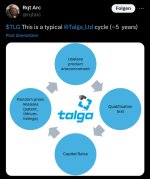Interesting announcement. First of all, who is UCC anyway? Never heard of them.
"United Catalyst Corporation, based in Fountain Inn, South Carolina, specializes in the recycling of scrap catalytic converters, focusing on recovering precious metals like platinum, palladium, and rhodium."
Ok.. not what I was expecting. Recycling catalysts is obvioysly suitable for gas powered cars. A shrinking business, both because the number of cars will become less, so its reducing feed material.. and the demand is reducing as well, probably much faster, as new catalysts are not needed as much. They are a shrinking business. As they are privately owned, we dont know for sure, but I bet the writing is on the wall. They need to expand into battery vehcles.. but I dont see how. Maybe they intend to recycle batteries but if so, they are not an established player.
Odd choice by Talga to be honest.
BlackBeak on HC noted:
Ok, that makes sense. To avoid another round of year long permitting processes, maybe Talga is looking to use the ground that is already permitted for the chemicals they need for recycling? Also, the announcement stated that they need a foothold in the US to gain access to government funding, which also makes sense. Also getting access to the network of customers is an interesting thing. Hopefully UCC didnt overstate their role..
Given the non-binding nature of the announcement, I dont know how much that would help, but at least its a start.


